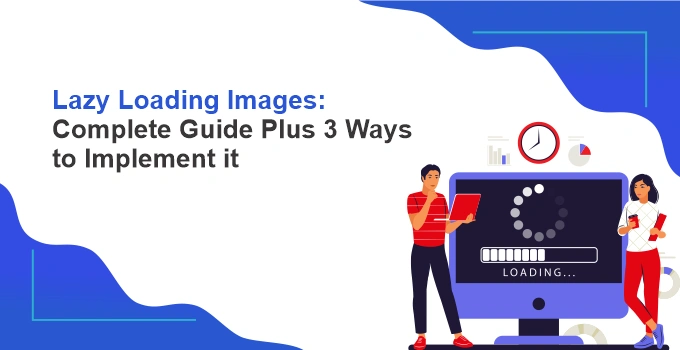Lazy Loading Images: Guide Plus 3 Ways to Implement It
As for usefulness and intuitiveness increment on the web, there has been a consistent expansion in page size throughout the most recent couple of years. As of mid-2018, the normal page size on the web remained at more than 2 MB! How to fight this? A little something many refer to as sluggish stacking pictures is one of the better arrangements.
In this guide, we go through every one of the complexities of sluggish stacking pictures, and talk about more than three distinct methods of carrying out it.
Do You Know What Lazy Loading is?
To see how lethargic stacking functions, here is a speedy vivified GIF showing how pictures are delivered on CodeinWP.
At the point when the page stacks, every one of the pictures is not downloaded right away. At the point when you look down at a picture, you first see an obscured rendition of it, and the real picture starts stacking behind the scenes. This obscured picture is a low-definition version of the last picture, for a portion of the size. This wonder of allowing downloading and delivering the picture till a client looks over it is exactly what’s called lethargic stacking.
Albeit “loading” is by and large related contrarily, lazy loading is really a decent practice and prompts bringing down page load times by enhancing your site generally speaking. After knowing about the lazy loading, the next question that will come to your mind is:
Does Lazy Loading Matter?
A gigantic load of a website page comprises principally of pictures, scripts, templates, textual styles, and recordings. In any case, pictures take up more than 60% of the size of a normal site page Pictures are additionally basic to the plan of a website page, so dislike you can dispose of them.
With no enhancement, the client’s internet browser downloads every one of the assets prior to delivering a page totally. This prompts expanded burden times, which can draw individuals away. Woo Commerce assessed that for each 100ms of page speed improvement, an internet business site can build an income by 1%.
In a situation like that, taking the necessary steps to streamline your heap times promises well. What’s more, since pictures are the essential supporter of page size, beginning with them is a smart thought. This is the place where lazy loading becomes possibly the most important factor.
Points to Consider While Using Lazy Loading Images
Since you have chosen to execute lazy loading on your site the correct way, let us go over a couple of key contemplations on the best way to complete it.
Distinguish the Pictures You Need to Lazy Burden
Not all pictures are ideal for lethargic stacking. For example, you wouldn’t have any desire to lazy load the ones that are basic to the construction of your plan and should be stacked to deliver everything effectively. Just the pictures that are off-screen and don’t add to the page’s design ought to be considered for sluggish stacking. Ordinarily, these are pictures in the <img> components that show up in the body of the page.
Pick Your Picture Placeholders
The following interesting point is the moderate picture or shading that ought to be shown when the picture is being stacked once a watcher has looked over it. The picture stacking time relies upon how enormous the picture is, and can even take up to a couple of moments. Thus, you should consider what you would like to use during the heap time.
There are two headings that engineers generally take in such a manner:
- Utilize the predominant shade of the picture as a foundation
- Utilize an inferior quality rendition of the picture
The correct decision here relies upon the plan of your site and what you would like to appear to the client when trusting that the picture will stack.
Albeit one strategy is to stack pictures when they enter the viewport, you might need to consider adding a support time before that happens – so the client never sees the placeholder. Be careful with adjusting page structure when stacking pictures.
Before a picture is loaded, it very well may be shown utilizing 0 px measurements. This isn’t ideal for keeping up your plan structure. This can undoubtedly change the design of the page and the position of the content. A straightforward arrangement is to add the right measurements to the picture immediately — this guarantees the size of the picture component stays as before after load.
With the above observations far removed, we should now take a look at how we can really carry out lazy loading on a WordPress site.
Option 1: Implement Lazy Loading without Any Preparation
Allow us first to see how to do this without utilizing any modules. This choice is suggested for those of you who are alright with JavaScript. In a perfect world, the accompanying advances should be taken:
Forestall picture loading during page load: When you indicate the URL or way of the picture in the src characteristic of the <img> tag, the picture will be downloaded by the program during page load. To keep the program from downloading the picture, you need to indicate the area of the picture in the information src quality of the <img> tag all things considered.
Register occasion overseer works in JavaScript to check for components on two occasions:
- loading
- looking over
At the point when a component comes into the viewport, load the worth of the information src component into the src component, which triggers the program to load the picture.
A straightforward execution of this interaction has been clarified by Robin Osborne and the demo is accessible on CodePen.
Click here to read: What is Instagram Threads App? Know Everything
Use the Crossing Point Observer API
The convergence spectator API recognizes DOM components that are in the viewport at some random point on schedule. This is a cleaner method of carrying out lazy loading without composing occasion controller capacities. The quantity of lines of code to carry out lazy loading goes down impressively as well. In any case, program similarity stays an issue.
The Google Developers Blog clarifies the execution of convergence spectator API through this CodePen demo.
Option 2: Use a JavaScript Plugin
The two choices talked about above need middle-level information on JavaScript. In the event that you are searching for a simpler execution of lazy loading without utilizing a weighty module that places load into the worker, you can attempt the plain JavaScript module, bLazy.
The bLazy library at a size of under 2 KB puts no extra burden on the payload, while permitting you to deal with sluggish stacking pictures without any problem.
To utilize the bLazy library, you need to instate <img> components with the accompanying ascribes:
- class: set the class of all <img> labels to b-lethargic
- src: connection to the placeholder picture
- information src: connection to the picture to stack
- information src-little: connection to the picture to stack on screens under 420 pixels wide
You need to instate the bLazy library in only a couple lines of code and every one of your pictures will be delivered through lazy loading.
Option 3: Use a WordPress Plugin
There two or three alternatives out there that can give you lethargic stacking. Most eminently:
- Lazy Load by WP Rocket
- Optimole
Every one of these modules will deal with sluggish stacking for you naturally. Each likewise accompanies some pleasant side highlights.
For instance, Lazy Load by WP Rocket likewise lazy loads YouTube recordings and replaces them with a thumbnail. Optimole, aside from being the most current expansion to the Themeisle family, additionally gives you unshakable picture enhancement (as tried here) with very progressed includes around there. For example, it gives you dynamic resizing dependent on the client’s screen size.
This post investigated the need and advantages of languid stacking pictures. We likewise examined three unique methods of carrying out apathetic stacking on a WordPress site. In the event that you have the middle-of-the-road capability in JavaScript, you can execute lazy loading without any preparation.
In the event that you realize some programming however don’t need any modules, a lightweight JavaScript library, bLazy is an alternative. In the event that you might want a single tick answer for lazy loading pictures on your site, you ought to go for a module like Optimole. What’s your opinion about lazy loading? Have you taken a stab at utilizing it to improve the exhibition of your site?



